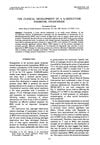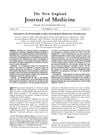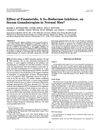TLDR Finasteride effectively treats BPH but may increase sexual dysfunction risk.
The study evaluated the effect of finasteride on men with benign prostatic hyperplasia (BPH). Finasteride inhibits the enzyme 5a-reductase, which prevents the conversion of testosterone to dihydrotestosterone, the androgen responsible for prostatic growth and enlargement. The study found that men treated with 5 mg of finasteride per day had a significant decrease in urinary symptoms, an increase in urinary flow, and a decrease in prostatic volume, but at a slightly increased risk of sexual dysfunction. The study concluded that finasteride is an effective treatment for BPH.
 211 citations
,
November 1990 in “The Journal of Steroid Biochemistry and Molecular Biology”
211 citations
,
November 1990 in “The Journal of Steroid Biochemistry and Molecular Biology” Finasteride effectively treats BPH, but needs more trials to understand potential.
 147 citations
,
April 1990 in “The Journal of Clinical Endocrinology and Metabolism”
147 citations
,
April 1990 in “The Journal of Clinical Endocrinology and Metabolism” Finasteride safely lowers DHT levels without affecting testosterone.
12 citations
,
January 1998 in “Drug safety” Finasteride helps reduce prostate size and symptoms in BPH but is less effective than terazosin and works best for larger prostates.
 1040 citations
,
October 1992 in “The New England Journal of Medicine”
1040 citations
,
October 1992 in “The New England Journal of Medicine” Finasteride effectively treats BPH but may increase sexual dysfunction risk.
 30 citations
,
August 1992 in “The Journal of Clinical Endocrinology and Metabolism”
30 citations
,
August 1992 in “The Journal of Clinical Endocrinology and Metabolism” Finasteride doesn't affect hormone levels in normal men.
 211 citations
,
November 1990 in “The Journal of Steroid Biochemistry and Molecular Biology”
211 citations
,
November 1990 in “The Journal of Steroid Biochemistry and Molecular Biology” Finasteride effectively treats BPH, but needs more trials to understand potential.




